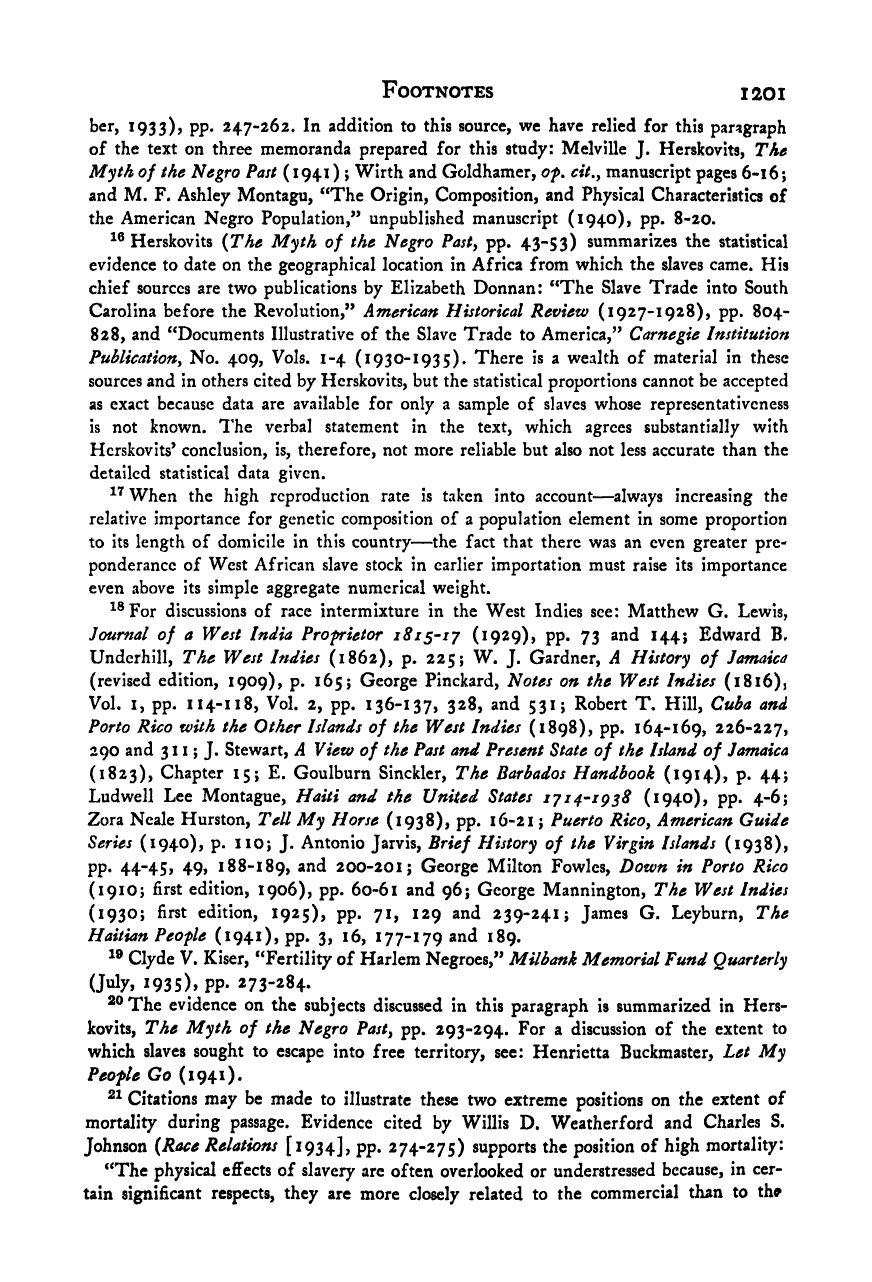Note: Gunnar Myrdal died in 1987, less than 70 years ago. Therefore, this work is protected by copyright, restricting your legal rights to reproduce it. However, you are welcome to view it on screen, as you do now. Read more about copyright.
Full resolution (TIFF) - On this page / på denna sida - Footnotes - Chapter 5

<< prev. page << föreg. sida << >> nästa sida >> next page >>
Below is the raw OCR text
from the above scanned image.
Do you see an error? Proofread the page now!
Här nedan syns maskintolkade texten från faksimilbilden ovan.
Ser du något fel? Korrekturläs sidan nu!
This page has never been proofread. / Denna sida har aldrig korrekturlästs.
Footnotes 1201
ber, 1933), pp. 247-262. In addition to this source, we have relied for this paragraph
of the text on three memoranda prepared for this study: Melville J. Herskovits, The
Myth of the Negro Past (1941 ) ;
Wirth and Goldhamer, of, cit,^ manuscript pages 6-16
;
and M. F. Ashley Montagu, “The Origin, Composition, and Physical Characteristics of
the American Negro Population,” unpublished manuscript (1940), pp. 8-20.
Herskovits {The Myth of the Negro Pasty pp. 43-53) summarizes the statistical
evidence to date on the geographical location in Africa from which the slaves came. His
chief sources are two publications by Elizabeth Donnan: “The Slave Trade into South
Carolina before the Revolution,” American Historical Review (1927-1928), pp. 804-
828, and “Documents Illustrative of the Slave Trade to America,” Carnegie Institution
Publicationy No. 409, Vols. 1-4 (1930-1935). There is a wealth of material in these
sources and in others cited by Herskovits, but the statistical proportions cannot be accepted
as exact because data are available for only a sample of slaves whose representativeness
is not known. The verbal statement in the text, which agrees substantially with
Herskovits’ conclusion, is, therefore, not more reliable but also not less accurate than the
detailed statistical data given.
When the high reproduction rate is taken into account—always increasing the
relative importance for genetic composition of a population element in some proportion
to its length of domicile in this country—the fact that there was an even greater pre-
ponderance of West African slave stock in earlier importation must raise its importance
even above its simple aggregate numerical weight.
^®For discussions of race intermixture in the West Indies see: Matthew G. Lewis,
Journal of a West India Profrietor 1^15-17 (1929), pp. 73 and 144; Edward B,
Underhill, The West Indies (1862), p. 225; W. J. Gardner, A History of Jamaica
(revised edition, 1909), p. 165; George Pinckard, Notes on the West Indies (1816),
Vol. I, pp. 114-118, Vol. 2, pp. 136-137, 328, and 531 ;
Robert T. Hill, Cuba and
Porto Rico with the Other Islands of the West Indies (1898), pp. 164-169, 226-227,
290 and 3 1 1 ; J. Stewart, A View of the Past and Present State of the Island of Jamaica
(1823), Chapter 15; E. Goulburn Sinckler, The Barbados Handbook (1914), p. 44;
Ludwell Lee Montague, Haiti and the United States (1940), pp. 4-6;
Zora Neale Hurston, Tell My Horse (1938), pp. 16-21 ;
Puerto RicOy American Guide
Series (1940), p. IIO; J. Antonio Jarvis, Brief History of the Virgin Islands (1938),
pp. 44-45, 49, 188-189, and 200-201; George Milton Fowles, Down in Porto Rico
(191O; first edition, 1906), pp. 60-6 1 and 96; George Mannington, The West Indies
(1930; first edition, 1925), pp. 71, 129 and 239-241 ;
James G. Leyburn, The
Haitian Peofie (1941), pp. 3, 16, 177-179 and 189.
Clyde V. Kiser, “Fertility of Harlem Negroes,” Milbank Memorial Fund Quarterly
(July, 1935), pp. 273-284.
The evidence on the subjects discussed in this paragraph is summarized in Hers-
kovits. The Myth of the Negro Pasty pp. 293-294. For a discussion of the extent to
which slaves sought to escape into free territory, see: Henrietta Buckmaster, Let My
Peofle Go (1941).
Citations may be made to illustrate these two extreme positions on the extent of
mortality during passage. Evidence cited by Willis D. Weatherford and Charles S.
Johnson {Race Relations [1934], pp. 274-275) supports the position of high mortality:
“The physical effects of slavery arc often overlooked or understressed because, in cer-
tain significant respects, they are more closely related to the commercial than to the
<< prev. page << föreg. sida << >> nästa sida >> next page >>